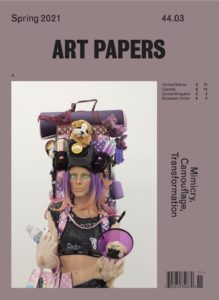Mimicry, Camouflage, Transformation
Share:
Today, most important things want to remain invisible.
—Hito Steyerl, How Not to be Seen: A Fucking Didactic Educational .MOV File (2013)
It was the Navy that figured out you could paint something with confusions so horror-bright that the eyeballs would get upset to where they refused to see. Battleships were painted this way and the bomber planes just passed them by.
—Lynda Barry, Cruddy
***
 For this issue of ART PAPERS, we set out to explore tensions between visibility and invisibility through artistic strategies of mimicry, camouflage, and transformation. The resulting essays, interviews, and artist projects reveal a tug of war between the benefits of representation and the right to opacity.
For this issue of ART PAPERS, we set out to explore tensions between visibility and invisibility through artistic strategies of mimicry, camouflage, and transformation. The resulting essays, interviews, and artist projects reveal a tug of war between the benefits of representation and the right to opacity.
Representation can create community, agency, and access, but it also leads inevitably to reductive depictions and stereotyping. The right to visibility, once granted, creates an almost immediate need for the privilege of refusal. It’s no surprise that this space of debate, which plays out in the visual field, proves perennially compelling for artists. Many, such as the ones featured in this issue, refuse certain contexts of representation, thereby rejecting modes of capture in favor of ambiguity or escape. These artists often mine this generative space to propose ways of looking and—depending on the viewer—limit what can be seen.
In nature, mimicry, camouflage, and transformation are adaptations that offer alternatives to fight or flight. The third option—to escape capture by confounding legibility—has the potential to shift the power dynamic of hunter and hunted. Through these gestures, it is possible to change the rules. In Seeing Sites Without Sightseeing Jack Radley interviews Claudia Peña Salinas; they discuss Peña Salinas’ use of “honest mimicry” to reveal rather than conceal, and her subverting of the tourist gaze upon archaeological and spiritual sites in Mexico. Mathilde Walker-Billaud’s essay Inaudibility: Krista Belle Stewart’s Sonic Repatriation of Knowledge mines the power of strategic incomprehensibility to reclaim ownership through the mediation of access and refusal.
Strategies of subterfuge and evasion have a curious, even counterintuitive relationship to spectacle, one that is deeply reliant upon milieu. Many contributions to this issue address how artists can communicate complex symbolic negotiations by manipulating the relationship between an object and its setting. What is more flamboyant than camouflage out of context, than mimicry exposed, or a transformation observed?
What is visible can depend less upon what is there than upon who is looking. These strategies of mimicry, camouflage, and transformation intervene on the space between what the eye sees and what the mind expects—between vision and knowledge. So by what knowledge do those who rely upon camouflage to disappear find one another? In The Poetics of Opacity Cosmo Whyte interviews Firelei Báez, and they discuss practices of coding, withholding, and “mixing the honey with the sting” in Báez’s symbolically layered works.
Constructed and socially enforced legibility can be made slippery by artistic interference, but in Architectural Camouflage and the Class Dynamics of Housing, Gabriel Cira reveals how confounding façades can also reinforce the dominant narrative by masking economic differences to favor a mirage of homogeneity. Sasha Cordingley explores the shift in representations of pro-democracy protests in Hong Kong, from the international news media’s spectacle to the intimate banalities of continual struggle, in Resisting the Spectacle—Tiffany Sia’s Never Rest/Unrest.
Stacy Lynn Waddell created a series of intricate imagined landscapes that were, appropriately, quite difficult to photograph. Her drawings, executed with searing heat and gold leaf, revel in the patterns of nature. María Korol’s artist project, Constitutionally Flawed, traces the subtext of history and autobiography in her practice of layered obfuscation. The text is accompanied by stills taken from her stop-motion animation of the same name, which can be viewed on ARTPAPERS.ORG.
Our review section does not always take up issue themes, but each of the reviews in this issue aligns with notions of mimicry, camouflage, or transformation. Chris Balaschak’s review of the traveling exhibition Cross Pollination at the Cummer Museum of Art & Gardens in Jacksonville, FL, shares a direct dialogue with Stacy Lynn Waddell’s artist project, while our cover image comes from a work in Nine Lives, Cajsa von Zeipel’s 2020 solo exhibition, which Caitlin Cherry reviews. Both EC Flamming’s take on the Hulu show PEN15 and Christopher Robert Jones’s consideration of Brontez Purnell’s 100 Boyfriends explore representations of self-awareness that allow for multiplicity, and even redemption.
Sarah Higgins
Editor + Artistic Director
editor@artpapers.org